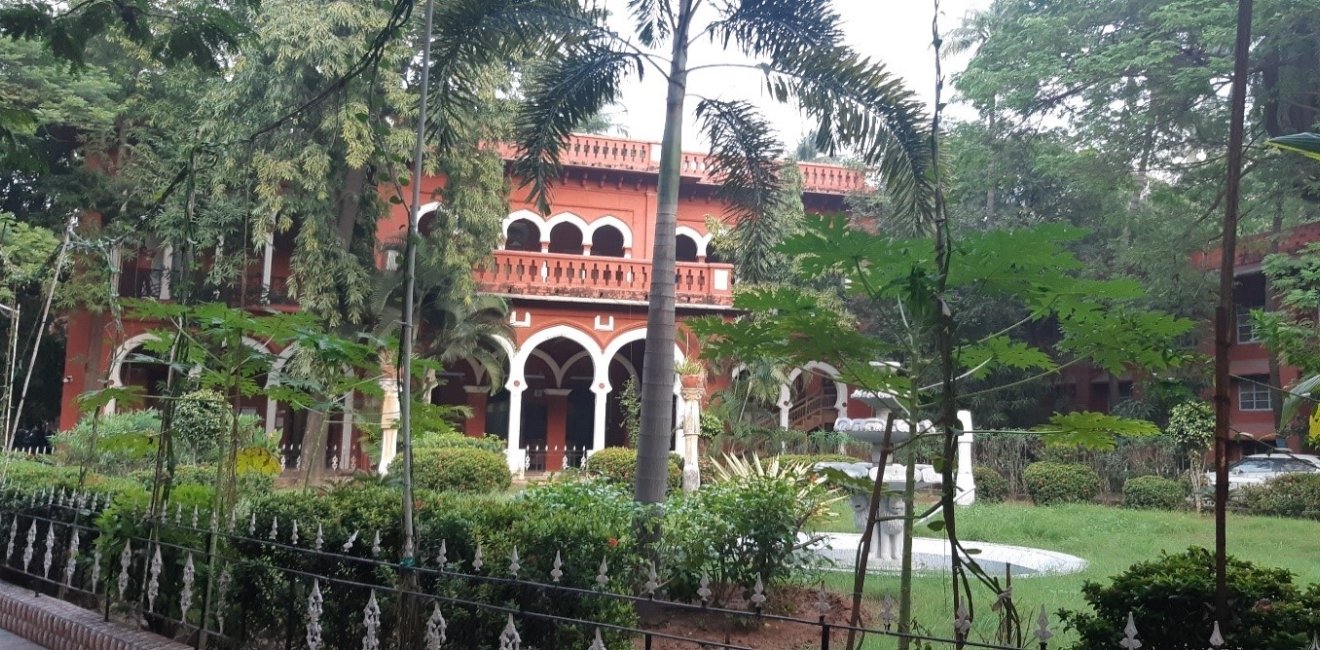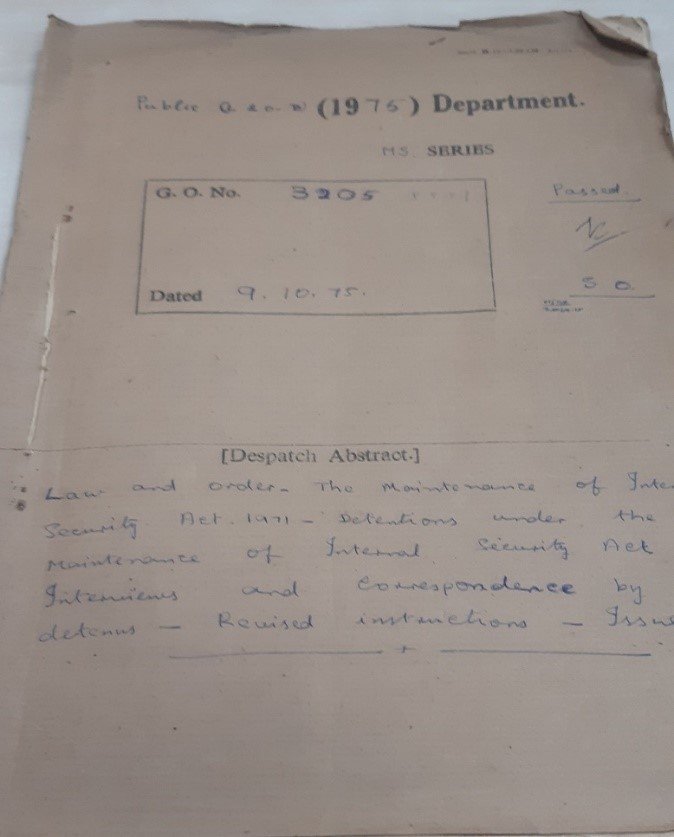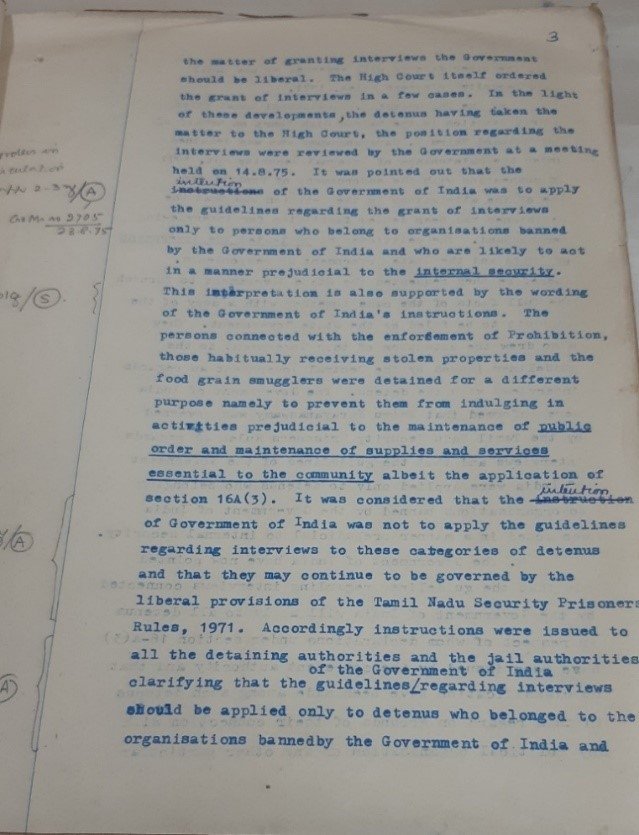Pencil Mightier than the Sword: How an Indian State Resisted Indira Gandhi
How marginalia on union government orders allowed Tamil Nadu to resist Indira Gandhi's Emergency.

A blog of the History and Public Policy Program
How marginalia on union government orders allowed Tamil Nadu to resist Indira Gandhi's Emergency.

In December 2021, I had the opportunity to visit the Tamil Nadu Aavanā Kaapagam (Tamil Nadu Archives) as part of my (COVID-affected and delayed) dissertation fieldwork. My project explores the state’s resistance against Indira Gandhi’s authoritarian rule in the mid-1970s, a period when all but two states implemented Gandhi’s “national Emergency” provisions. At the Tamil Nadu Archives, I gained access to documents related to detentions made under the infamous Maintenance of Internal Security Act (MISA). These sources demonstrated that Tamil Nadu’s lax implementation of the Emergency proved irksome enough for Gandhi to dissolve the state government and impose central rule. What follows is a brief overview of the Emergency and my experience uncovering evidence at the TNA.
On 26 June 1975, two weeks after a High Court verdict voided her electoral victory and barred her from holding an elected office, India’s Prime Minister Indira Gandhi imposed a state of “national Emergency.” She claimed that the political disorder that ensued after the verdict was a threat to national security. Using the sweeping powers granted to her by the emergency decree, Gandhi arrested scores of political opponents and activists, censored the press, and postponed state elections. On 7 November 1975, five months into the Emergency, the Supreme Court formally overturned the lower court’s conviction. Gandhi’s actions marred India’s exceptional record of being a stable postcolonial democracy.
Two state governments – Gujarat and Tamil Nadu – resisted Gandhi’s autocratic onslaught. Refusing to implement the Emergency within their jurisdictions, both states made very few political arrests, permitted protests against the union government, and served as safe havens for opposition leaders to organize anti-government activities.
For their part in resisting the Emergency, both states came under the union government’s direct control by early 1976. The Tamil Nadu government was dissolved seven weeks ahead of a planned state election on 31 January 1976. The Gujarat government lost its coalition support by a margin of two votes, compelling the Chief Minister to resign and allowing the minority Congress party (Mrs. Gandhi’s party at the national level) to come to power.
Archives in postcolonial nations are commonly thought of as colonial relics that are dimly lit, poorly air-conditioned, and crumbling edifices of neglect, red tape, and secrecy. However, I found the TNA to be just the opposite: a bustling, functioning, and accessible institution. Despite the pandemic, the TNA had regular foot traffic from both researchers and citizens who wanted access to personal records (such as birth and death certificates, marriage licenses, inheritance and adoption papers, and land titles). I paid a nominal registration fee of Rs. 700 (about $10 at the time), and I was able to enroll as a researcher the very same day.
While perusing older editions of Tamil Arasu - the fortnightly magazine published by the Department of Information and Public Relations - I learned about the state’s history of secessionism and autonomy that began in the 1940s, predating India’s independence. In 1969, the newly elected Chief Minister of Tamil Nadu, M. Karunanidhi, made a bold and unprecedented move. He formed the Center-State Relations Inquiry Committee with the explicit mandate of recommending constitutional amendments to increase state autonomy.
With tensions already ongoing between the Tamil state and the union government, the Tamil Nadu leadership opted not to follow the other Indian states in implementing the Emergency order.
One way Tamil Nadu resisted was to modify the union government’s orders in a manner that allowed state law to supersede union law. This modification was most clearly visible when it came to the treatment of detainees under the draconian MISA. The legislation, enacted in 1971, allowed law enforcement agencies to indefinitely detain individuals, search and seize property without warrants, and wiretap citizens. Between 1975 and 1977, MISA was invoked to arrest nearly 100,000 people including activists, journalists, scholars, opposition politicians, and private citizens. At TNA, I was able to read numerous Government Orders (GOs) that detailed arrests that were made under MISA.

I observed a particularly glaring modification in Government Order No. 3205 dated 9 October 1975, wherein civil servants from Tamil Nadu’s Public Department and the Law and Order Department changed the language and intention of the union government’s order. They replaced the word “instruction” with the word “intention,” which allowed the state government some latitude to implement the directive as they saw fit.

Note the letter A written and circled in pencil (Ⓐ) on the left margin of the document at three places. The notations were made by one of the document’s reviewers, with the aim of selecting those parts of the directive that allowed the state to follow its desired interpretation of the union government’s demand. A close reading of the selected fragments on the page tells us that the state was justifying the application of “the liberal provisions of the Tamil Nadu Security Prisoners Rules, 1971,” instead of the measures specified by MISA concerning the detainees. The pencilled margin notes received official sanction and approval when reviewers noted that:
"Since GOI (Government of India) themselves have stated that the conditions of the detenus under MISA would be governed by the order in force of the respective state governments, Ⓐ above may be agreed to. All order in pursuance of the guidelines of the GOI on this question may be cancelled." (emphasis added)
I noticed the use of pencilled notes, scribbles, and directions in the margins of other GOs, and understood that marginalia was frequently used as the basis for modifying, clarifying, and re-wording orders. While not in direct contravention of directives from the union government, these modifications helped dilute the severity of the punitive measures ordered by New Delhi and ensured that Emergency mandates were only partially implemented by the state.
For their role in ensuring the continuity of democratic administration, several senior leaders of Tamil Nadu’s cabinet were imprisoned and tortured for up to a year. Another Member of Parliament who served as the mayor of the state’s capital city died of injuries sustained from the torture.
Examples such as Tamil Nadu’s resistance to Indira Gandhi’s Emergency can only be uncovered at regional archives. Yet these repositories are often overshadowed by a scholarly focus on national archives as loci of history and information. Through my visit to the Tamil Nadu Archives, I have come to understand that regional archives can serve as spaces for scholars and citizens who are keen on revisiting the past in order to reimagine the future of resistance and democracy.
The author would like to extend their gratitude to Mr. Jegan Parthiban (TNA Librarian), Mr. Madanagopal, and Mr. Neelavannan (TNA Document Procurement Officers) for their patient and invaluable guidance during their visit to the Tamil Nadu Archives. They are also thankful to Professor Joseph Torigian and Dr. Charles Kraus for their feedback.

A leader in making key foreign policy records accessible and fostering informed scholarship, analysis, and discussion on international affairs, past and present. Read more



